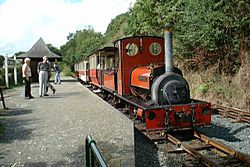Launceston Steam Railway facts for kids
Quick facts for kids Launceston Steam Railway |
|
|---|---|
 |
|
| Locale | Launceston, Cornwall, UK |
| Terminus | Launceston |
| Commercial operations | |
| Name | North Cornwall Railway |
| Original gauge | 4 ft 8 1⁄2 in (1,435 mm) standard gauge |
| Preserved operations | |
| Owned by | The Spice Settlement Trust Co. Ltd |
| Operated by | The Spice Settlement Trust Co. Ltd |
| Stations | 4 |
| Length | 2+1⁄2 miles (4 km) |
| Preserved gauge | 1 ft 11 1⁄2 in (597 mm) |
| Commercial history | |
| Opened | 21 July 1892 |
| Closed | 30 January 1967 |
| Preservation history | |
| 1965 | Steam locomotive Lilian rescued |
| 1983 | Launceston Steam Railway opened |
| 1995 | Extension to Newmills opened |
The Launceston Steam Railway is a fun, narrow-gauge railway in Cornwall, England. It's about 2.5 miles (4 km) long. The railway takes you on a scenic trip from the town of Launceston to Newmills, where you can visit a farm park. This special railway was built on the path of an older, bigger railway line.
Contents
History
How Railways Came to Launceston
The very first railway arrived in Launceston in 1865. It connected Launceston to Plymouth. Later, another railway line opened in 1886, linking Launceston to Padstow. For a while, Launceston had two train stations right next to each other! These older railways eventually closed down in the 1960s.
Bringing Steam Back to Life
In 1965, a young teacher named Nigel Bowman saved a steam train called Lilian. He found her at a slate quarry in North Wales. Nigel worked hard to fix Lilian at his home. He then looked for a place to build a railway for her to run on. In 1971, he chose Launceston.
It took several years to buy the land for the railway. The first half-mile of track opened on Boxing Day in 1983. The railway slowly grew longer. In 1995, it reached Newmills, making it 2.5 miles long. This is the railway's length today.
The Railway Route
The Launceston Steam Railway starts at a new station. This station is just west of where the old railway station used to be. Launceston station is the main hub for the railway. This is where the train sheds and repair shops are located.
From the station, the line goes through a deep cut in the ground. It passes under a road bridge and a water channel called an aqueduct. Then, it crosses the River Kensey on a two-arch bridge called a viaduct. The railway then runs on a raised bank of earth, known as an embankment. It crosses a farm track before reaching Hunt's Crossing. There are plans to add a passing loop here, which lets trains pass each other.
After Hunt's Crossing, the line crosses two more farm paths. It then reaches Canna Park. This was the end of the line for a while before it was extended. From Canna Park, it's a short ride to Newmills, the final stop. Right next to Newmills station is the Newmills Farm Park.
Locomotives
The Launceston Steam Railway uses different types of trains. The steam locomotives pull all the passenger trains. The other trains, which use engines like cars, are used for maintenance work.
Steam Locomotives
| Name | Builder | Built | Origin | Notes |
|---|---|---|---|---|
| Lilian | Hunslet Engine Company | 1883 | Penrhyn Quarry | Got a new boiler in 1993 and a tender (for water and fuel) in 2008. It was fully checked and repaired in 2016. |
| Covertcoat | Hunslet Engine Company | 1898 | Dinorwic Quarry | A cab (driver's area) and tender were added at Launceston. |
| Dorothea | Hunslet Engine Company | 1901 | Dorothea Quarry | Restored over 22 years by Kay Bowman. It first ran in 2011 and started carrying passengers in 2012. |
| Perseverance | C. Parmenter | 2004 | First built on a wagon frame, then rebuilt with a new frame in 2010. |
Other Locomotives
These trains are used for work around the railway, not usually for passengers.
| Name | Builder | Built | Notes |
|---|---|---|---|
| English Electric | 1930 | On display in the museum. | |
| Motor Rail | 1933 | ||
| N. Bowman | 1986 | An inspection trolley (small vehicle for checking tracks). | |
| Launceston Steam Railway | 2004 | Another inspection trolley. | |
| The Gherkin | Launceston Steam Railway | 2010-2017 | A new diesel railcar built by the railway itself. |
Visiting Locomotives
Sometimes, other special trains visit the Launceston Steam Railway.
| Name | Builder | Year Visited | Notes |
|---|---|---|---|
| Lilla | Hunslet | 1998 | From the Ffestiniog Railway. |
| Pearl 2 | A. Civil | 2001 | From the Golden Valley Light Railway. |
| Dame Ann | Exmoor Steam Railway | 2004 | From the Wales West Light Railway in Alabama, USA. |
| Sharp Stewart | 2009 & 2019 | This is Darjeeling Himalayan Railway 778. | |
| Gertrude | Andrew Barclay Sons & Co. | 2009 | From Exmoor Transport. |
| Lyd | Boston Lodge Works | 2010 | From the Ffestiniog Railway. |
| Roanoke Engineering | 2010 & 2011 | A private vertical boiler tram locomotive. |
Rolling Stock
The railway has four passenger carriages. These were all built right there at the railway. Their design is based on carriages from other historic railways. The railway also has several old box vans, slate wagons, and tipping wagons. These came from a Royal Naval Armaments Depot.

